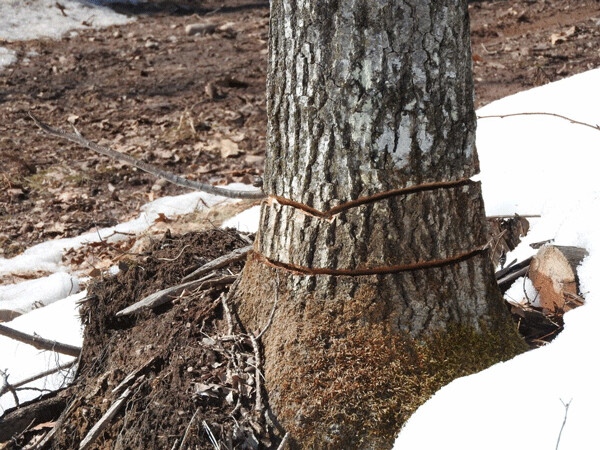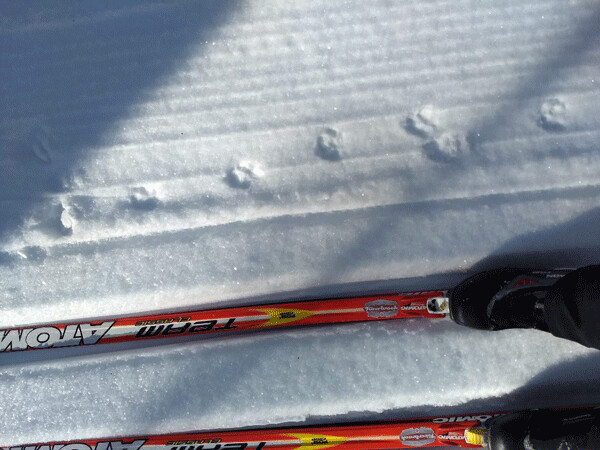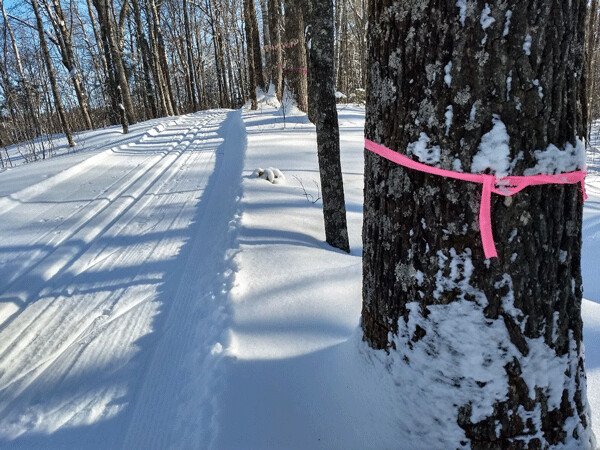News & Articles
Browse all content by date.

Earlier this winter, I chose a bluebird day to swoop joyfully around the 16k loop at the Rock Lake Ski Trails. Fox tracks trotted over the recent grooming, making perfect imprints in the light dusting of giant flakes that had fallen in the pre-dawn hours. The surface of every drift sparkled among stately trees.
These ski trails are known for their rollercoaster hills. In many places, your exhilarating downhill momentum will carry you all the way up to the crest of the next rise. As I was doing just that – coasting up the other side of a hill out on the farthest part of the loops – flash of pink caught my eye. Several trees in a cluster were ringed with neon flagging tape. My heart sank. Not here, too!
Sidestepping over to the closest one, I scanned the trunk until I found it – right at snow level was a saw mark in the bark, completely encircling the tree. The cut had done its job of preventing the flow of water and nutrients from roots to crown. The result was death. This oak had been girdled purposely.
While the dead trees made me sad, I wasn’t mad at the person who had cut into them. Some responsible forester was just doing their best to prevent the spread of oak wilt. Oak wilt is a fungal pathogen that kills trees in a single season. While it’s already widespread in southern Wisconsin, it has only just arrived here in the north in 2018.
Sap beetles in the family Nitidulidae are one of the main vectors for oak wilt. When an oak tree is injured – by a bulldozer, trail groomer, wind storm, etc. – sweet juices begin oozing from its wounds, and that scent lures in hungry beetles. If those beetles have already been eating from a tree infected by the oak wilt fungus, they will transport spores and inoculate a new infection.
The fungus works quickly to invade the tree’s water conducting system. While white oaks seem to be able to mount a defense and exhibit a degree of resistance to the disease, the red oaks that are dominant up here don’t stand a chance. The oak’s leaves wilt from the crown down, in the middle of summer, and within a month the tree is dead.

Beetles aren’t the only way that oak wilt spreads, though. The fungus can travel through the tree’s roots, pass through root grafts with nearby oaks, and kill them, too. I’ve written about the incredible connectedness of trees and fungi in the “wood wide web,” and how those networks facilitate communication, cooperation, and forest health. But sometimes – as we humans are discovering – an interconnected world is a more dangerous one when a new disease shows up on the scene.
One of these oaks probably died naturally from the fungus. The other, potentially connected trees, were girdled and painted with herbicide. While it sounds drastic, this is the most reliable method to make sure that there aren’t infected root grafts that will spread the fungus below ground. You might even call it a type of tree quarantine, or social distancing.
By using these precautions, hopefully just a few trees will die, rather than every oak in the forest. They are still salvageable as lumber, and even the fungus-killed trees can be used for firewood if you quarantine the logs under plastic for a year so that beetles can’t access them and spread their fungal spores.
Paul Cigan, a forest health specialist with the Wisconsin Department of Natural Resources, can’t say it enough: the only thing that will prevent oak wilt from becoming a widespread problem in our forests up here is responsible landowners and preventative care. There were 50 new oak wilt infections in 2019. That includes 5 in Sawyer County, 12 in Bayfield County, and 32 in Washburn County. Four of those are in locations – and on ski trails – that are dear to my heart. This disease feels personal.

Luckily, there are many things we can do to prevent oak wilt. The beetle that spreads oak wilt can’t chew its own holes. We can be careful not to make holes for them. During the fungus’s active time, from April through July, how you treat your oak trees can mean the difference between life and death for them. Any sort of wound, whether it’s a scrape from a bulldozer, a pruning cut, a logged stump, or even a broken twig can be the entry point for oak wilt into your forest, and your neighbor’s forest, too.
Using wound-sealer to cover injuries immediately can help. (Beetles can find a new wound in 15 minutes or less!) Paying close attention to your forest is also important. Keep an eye out for oaks with wilting leaves. When caught early by observant landowners and reported to your local Department of Natural Resources office, infections can be contained.
Private landowners are not alone in this fight. Foresters from the counties, the Wisconsin DNR, and the United States Forest Service are working together on their large-scale oak wilt detection and mitigation operations. Aerial surveys with planes and drones, and satellite imagery with computer analysis that can spot sick trees are at the forefront.
Oaks are a major component in our forests, and they are important ecologically, economically, and aesthetically. Preventing oak wilt will be a team effort.
Emily’s second book, Natural Connections: Dreaming of an Elfin Skimmer, is now available to purchase at www.cablemuseum.org/books and at your local independent bookstore, too.
For more than 50 years, the Cable Natural History Museum has served to connect you to the Northwoods. Our Curiosity Center remains open, and Mysteries of the Night will open on May 1, 2020. Call us at 715-798-3890 or email emily@cablemuseum.org.
| Tweet |


